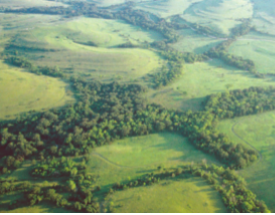The National Science Foundation (NSF) has awarded UC Santa Cruz soil scientist Dr. Weixin Cheng and his collaborators (Drs. John Blair of Kansas State Univ., and Gail Wilson of Oklahoma State Univ.) a three-year grant of $800,000 to investigate how plant roots and associated soil microorganisms stimulate or suppress the decomposition of organic matter in soil, a process known as the “rhizosphere priming effect” (RPE).
Unlocking the complexity of rhizosphere processes is one of the key stumbling blocks to understanding how terrestrial ecosystems store and release carbon and nitrogen belowground. Many global change phenomena (e.g., climate change, elevated CO2) alter rhizospheric processes, which may have important consequences for ecosystems. The results of this study will be integrated into large-scale mathematical models and will influence other areas of ecosystem and global change science.
The rhizosphere refers to the microscopic zone where live roots and soil microbes interact to break down soil organic matter (i.e., matter derived from dead organisms), and cycle nitrogen and carbon. Put another way, if you picture the garden in your backyard, virtually all below-ground biochemical interactions take place in the microscopic zone of space around living roots. The research funded by this grant will focus on measuring the contribution of living roots to the breakdown of soil organic matter in the rhizosphere and thus to the release of carbon dioxide (CO2) from the soil into the atmosphere.
According to the researchers, this will be the first rigorous effort to measure the RPE under realistic field conditions. Dr. Cheng’s extensive laboratory studies over two decades show that RPE is as important to the breakdown of soil organic matter as the two other main controls on below-ground soil organic matter decomposition -- heat and water. Methodological hurdles, however, have challenged scientists’ attempts to understand the role that RPE plays in soil organic matter decomposition in natural field conditions.
In order to overcome these hurdles, Cheng has developed an innovative method that minimizes disturbance to living roots while providing a way to measure how much CO2 is released from soil organic matter due to RPE. This study also takes advantage of special conditions at the Long-Term Ecological Research site in Kansas where soil organic matter produced by past grassy plants has a different isotopic signature than the organic matter produced by invading woody plants. Measuring these different isotopic signatures will enable the team to definitively determine the amount of CO2 that is released from soil organic matter due to the RPE of living plant roots. The researchers will study the RPE across a wide variety of plant species, growing conditions (e.g., temperature, light, moisture, and CO2 levels), and time scales.
Dr. Cheng says, “Our goal now is to firmly ‘root’ rhizosphere research in more ecologically realistic settings to better understand patterns and controls of the RPE in nature.”
The researchers will train nine undergraduate and three graduate students and rigorously recruit these students from underrepresented groups using programs at UCSC, Kansas State, and Oklahoma State Universities. They will also integrate their results and innovative methods into courses at all three universities and share their research with the general public.

